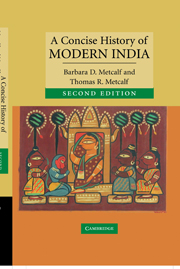Book contents
- Frontmatter
- Contents
- List of illustrations
- Preface to the second edition
- Preface to the first edition
- Glossary
- Chronology
- 1 Sultans, Mughals, and pre-colonial Indian society
- 2 Mughal twilight: the emergence of regional states and the East India Company
- 3 The East India Company Raj, 1772–1850
- 4 Revolt, the modern state, and colonized subjects, 1848–1885
- 5 Civil society, colonial constraints, 1885–1919
- 6 The crisis of the colonial order, 1919–1939
- 7 The 1940s: triumph and tragedy
- 8 Congress Raj: democracy and development, 1950–1989
- 9 Democratic India in the nineties: coalitions, class, community, consumers, and conflict
- Epilogue: a new century begins
- Biographical notes
- Bibliographic essay
- Index
- CAMBRIDGE CONCISE HISTORIES
6 - The crisis of the colonial order, 1919–1939
Published online by Cambridge University Press: 05 June 2012
- Frontmatter
- Contents
- List of illustrations
- Preface to the second edition
- Preface to the first edition
- Glossary
- Chronology
- 1 Sultans, Mughals, and pre-colonial Indian society
- 2 Mughal twilight: the emergence of regional states and the East India Company
- 3 The East India Company Raj, 1772–1850
- 4 Revolt, the modern state, and colonized subjects, 1848–1885
- 5 Civil society, colonial constraints, 1885–1919
- 6 The crisis of the colonial order, 1919–1939
- 7 The 1940s: triumph and tragedy
- 8 Congress Raj: democracy and development, 1950–1989
- 9 Democratic India in the nineties: coalitions, class, community, consumers, and conflict
- Epilogue: a new century begins
- Biographical notes
- Bibliographic essay
- Index
- CAMBRIDGE CONCISE HISTORIES
Summary
The year 1919 was a watershed in the modern history of India. Nothing was the same afterwards. By its end the Montagu–Chelmsford reforms, in prospect since the previous year, were enacted. While the reforms withheld swaraj, the ‘self-rule’ increasingly demanded by nationalists, they foreshadowed a period when Indians would determine their own fate. The year, however, also brought the repressive Rowlatt bills and the catastrophe of the Amritsar massacre. For many, if not most, Indians the reforms had become a poisoned chalice. They chose instead a novel course of political action, that of ‘non-violent non-cooperation’, and a new leader, Mohandas K. Gandhi, only recently returned from twenty years in South Africa. Gandhi would endure as a lasting symbol of moral leadership for the entire world community.
REFORM AND REPRESSION
In August 1917 Edwin Montagu announced that the objective of British rule in India would be the ‘gradual development of self-governing institutions with a view to the progressive realization of responsible government in India as an integral part of the British Empire’. This declaration decisively repudiated the old ‘durbar’ model of Indian politics. India would instead follow the path already chalked out by the white-settler dominions of Canada, Australia, and New Zealand. Inevitably, too, it meant that, rather than disdaining the educated as an unrepresentative minority, the British would repose in them the confidence due future leaders of India. These men were, Montagu averred, in a telling comment on the declaration, ‘intellectually our children’, who had ‘imbibed ideas which we ourselves have set before them’.
- Type
- Chapter
- Information
- A Concise History of Modern India , pp. 167 - 202Publisher: Cambridge University PressPrint publication year: 2006

